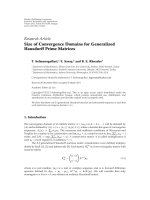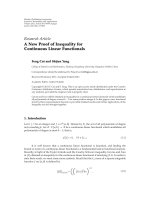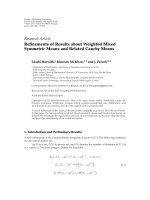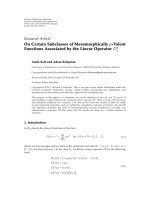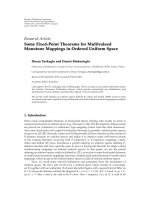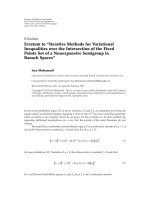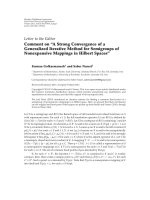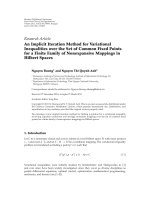Hindawi Publishing Corporation Advances in Difference Equations Volume 2011, Article ID 107384, 11 doc
Bạn đang xem bản rút gọn của tài liệu. Xem và tải ngay bản đầy đủ của tài liệu tại đây (494.12 KB, 11 trang )
Hindawi Publishing Corporation
Advances in Difference Equations
Volume 2011, Article ID 107384, 11 pages
doi:10.1155/2011/107384
Research Article
New Existence Results for Nonlinear Fractional
Differential Equations with Three-Point Integral
Boundary Conditions
Bashir Ahmad,
1
Sotiris K. Ntouyas,
2
and Ahmed Alsaedi
1
1
Department of Mathematics, Faculty of Science, King Abdulaziz University, P.O. Box 80203,
Jeddah 21589, Saudi Arabia
2
Department of Mathematics, University of Ioannina, 451 10 Ioannina, Greece
Correspondence should be addressed to Bashir Ahmad, bashir
Received 30 October 2010; Revised 12 December 2010; Accepted 12 December 2010
Academic Editor: Dumitru Baleanu
Copyright q 2011 Bashir Ahmad et al. This is an open access article distributed under the Creative
Commons Attribution License, which permits unrestricted use, distribution, and reproduction in
any medium, provided the original work is properly cited.
This paper studies a boundary value problem of nonlinear fractional differential equations of order
q ∈ 1, 2 with three-point integral boundary conditions. Some new existence and uniqueness
results are obtained by using standard fixed point theorems and Leray-Schauder degree theory.
Our results are new in the sense that the nonlocal parameter in three-point integral boundary
conditions appears in the integral part of the conditions in contrast to the available literature
on three-point boundary value problems which deals with the three-point boundary conditions
restrictions on the solution or gradient of the solution of the problem. Some illustrative examples
are also discussed.
1. Introduction
In recent years, boundary value problems for nonlinear fractional differential equations
have been addressed by several researchers. Fractional derivatives provide an excellent
tool for the description of memory and hereditary properties of various materials and
processes; see 1. These characteristics of the fractional derivatives make the fractional-
order models more realistic and practical than the classical integer-order models. As a
matter of fact, fractional differential equations arise in many engineering and scientific
disciplines such as physics, chemistry, biology, economics, control theory, signal and image
processing, biophysics, blood flow phenomena, aerodynamics, and fitting of experimental
data, 1–4. For some recent development on the topic, see 5–21 and the references
therein.
2 Advances in Difference Equations
We discuss the existence and uniqueness of solutions for a boundary value problem
of nonlinear fractional differential equations of order q ∈ 1, 2 with three-point integral
boundary conditions given by
c
D
q
x
t
f
t, x
t
, 0 <t<1, 1 <q≤ 2,
x
0
0,x
1
α
η
0
x
s
ds, 0 <η<1,
1.1
where
c
D
q
denotes the Caputo fractional derivative of order q, f : 0, 1 × X → X is
continuous, and α ∈ R is such that α
/
2/η
2
. Here, X, · is a Banach space and C
C0, 1,X denotes the Banach space of all continuous functions from 0, 1 → X endowed
with a topology of uniform convergence with the norm denoted by ·.
Note that the three-point boundary condition in 1.1 corresponds to the area under
the curve of solutions xt from t 0tot η.
2. Preliminaries
Let us recall some basic definitions of fractional calculus 2, 4.
Definition 2.1. For a continuous function g : 0, ∞ → R, the Caputo derivative of fractional
order q is defined as
c
D
q
g
t
1
Γ
n − q
t
0
t − s
n−q−1
g
n
s
ds, n − 1 <q<n, n
q
1,
2.1
where q denotes the integer part of the real number q.
Definition 2.2. The Riemann-Liouville fractional integral of order q is defined as
I
q
g
t
1
Γ
q
t
0
g
s
t − s
1−q
ds, q > 0,
2.2
provided the integral exists.
Definition 2.3. The Riemann-Liouville fractional derivative of order q for a continuous
function gt is defined by
D
q
g
t
1
Γ
n − q
d
dt
n
t
0
g
s
t − s
q−n1
ds, n
q
1,
2.3
provided the right-hand side is pointwise defined on 0, ∞.
Advances in Difference Equations 3
Lemma 2.4 see 2. For q>0, the general solution of the fractional differential equation
c
D
q
xt
0 is given by
x
t
c
0
c
1
t c
2
t
2
··· c
n−1
t
n−1
,
2.4
where c
i
∈ R, i 0, 1, 2, ,n− 1 (n q1).
In view of Lemma 2.4, it follows that
I
q
c
D
q
x
t
x
t
c
0
c
1
t c
2
t
2
··· c
n−1
t
n−1
,
2.5
for some c
i
∈ R, i 0, 1, 2, ,n− 1 n q1.
Lemma 2.5. A unique solution of the boundary value problem 1.1 is given by
x
t
1
Γ
q
t
0
t − s
q−1
f
s, x
s
ds
−
2t
2 − αη
2
Γ
q
1
0
1 − s
q−1
f
s, x
s
ds
2αt
2 − αη
2
Γ
q
η
0
s
0
s − m
q−1
f
m, x
m
dm
ds.
2.6
Proof. For some constants c
0
,c
1
∈ X, we have
x
t
I
q
ρ
t
− c
0
− c
1
t
t
0
t − s
q−1
Γ
q
y
s
ds − c
0
− c
1
t.
2.7
From x00, we have c
0
0. Applying the second boundary condition for 1.1,wefind
that
α
η
0
x
s
ds α
η
0
s
0
s − m
q−1
Γ
q
f
m, x
m
dm − c
1
s
ds
α
η
0
s
0
s − m
q−1
Γ
q
f
m, x
m
dm
ds − αc
1
η
2
2
,
x
1
1
0
1 − s
q−1
Γ
q
f
s, x
s
ds − c
1
,
2.8
4 Advances in Difference Equations
which imply that
c
1
2
2 − αη
2
1
0
1 − s
q−1
Γ
q
f
s, x
s
ds − α
η
0
s
0
s − m
q−1
Γ
q
f
m, x
m
dm
ds
. 2.9
Substituting the values of c
0
and c
1
in 2.7, we obtain the solution 2.6.
In view of Lemma 2.5, we define an operator F : C→Cby
Fx
t
1
Γ
q
t
0
t − s
q−1
f
s, x
s
ds
−
2t
2 − αη
2
Γ
q
1
0
1 − s
q−1
f
s, x
s
ds
2αt
2 − αη
2
Γ
q
η
0
s
0
s − m
q−1
f
m, x
m
dm
ds, t ∈
0, 1
.
2.10
To prove the main results, we need the following assumptions:
A
1
ft, x − ft, y≤Lx − y, for all t ∈ 0, 1, L>0, x, y ∈ X;
A
2
ft, x≤μt, for all t, x ∈ 0, 1 × X,andμ ∈ L
1
0, 1,R
.
For convenience, let us set
Λ
1
Γ
q 1
1
2
q 1
|
α
|
η
q1
2 − αη
2
q 1
. 2.11
3. Existence Results in a Banach Space
Theorem 3.1. Assume that f : 0, 1 × X → X is a jointly continuous function and satisfies the
assumption A
1
with L<1/Λ,whereΛ is given by 2.11. Then the boundary value problem 1.1
has a unique solution.
Advances in Difference Equations 5
Proof. Setting sup
t∈0,1
|ft, 0| M and choosing r ≥ ΛM/1 − LΛ, we show that FB
r
⊂ B
r
,
where B
r
{x ∈C: x≤r}. For x ∈ B
r
, we have
Fx
t
≤
1
Γ
q
t
0
t − s
q−1
f
s, x
s
ds
2t
2 − αη
2
Γ
q
1
0
1 − s
q−1
f
s, x
s
ds
2αt
2 − αη
2
Γ
q
η
0
s
0
s − m
q−1
f
m, x
m
dm
ds
≤
1
Γ
q
t
0
t − s
q−1
f
s, x
s
− f
s, 0
f
s, 0
ds
2t
2 − αη
2
Γ
q
1
0
1 − s
q−1
f
s, x
s
− f
s, 0
f
s, 0
ds
2αt
2−αη
2
Γ
q
η
0
s
0
s−m
q−1
f
m, x
m
−f
m, 0
f
m, 0
dm
ds
≤
Lr M
1
Γ
q
t
0
t − s
q−1
ds
2t
2 − αη
2
Γ
q
1
0
1 − s
q−1
ds
2αt
2 − αη
2
Γ
q
η
0
s
0
s − m
q−1
dm
ds
≤
Lr M
Γ
q 1
1
2
q 1
|
α
|
η
q1
2 − αη
2
q 1
Lr M
Λ ≤ r.
3.1
Now, for x, y ∈Cand for each t ∈ 0, 1,weobtain
Fx
t
−
Fy
t
≤
1
Γ
q
t
0
t − s
q−1
f
s, x
s
− f
s, y
s
ds
2t
2 − αη
2
Γ
q
1
0
1 − s
q−1
f
s, x
s
− f
s, y
s
ds
2αt
2−αη
2
Γ
q
η
0
s
0
s−m
q−1
f
m, x
m
−f
m, y
m
dm
ds
6 Advances in Difference Equations
≤ L
x − y
1
Γ
q
t
0
t − s
q−1
ds
2t
2 − αη
2
Γ
q
1
0
1 − s
q−1
ds
2αt
2 − αη
2
Γ
q
η
0
s
0
s − m
q−1
dm
ds
≤
L
Γ
q 1
1
2
q 1
|
α
|
η
q1
2 − αη
2
q 1
x − y
LΛ
x − y
,
3.2
where Λ is given by 2.11. Observe that Λ depends only on the parameters involved in the
problem. As L<1/Λ, therefore F is a contraction. Thus, the conclusion of the theorem follows
by the contraction mapping principle Banach fixed point theorem.
Now, we prove the existence of solutions of 1.1 by applying Krasnoselskii’s fixed
point theorem 22.
Theorem 3.2 Krasnoselskii’s fixed point theorem. Let M be a closed convex and nonempty
subset of a Banach space X.LetA, B be the operators such that (i) Ax By ∈ M whenever x, y ∈ M;
(ii) A is compact and continuous; (iii) B is a contraction mapping. Then there exists z ∈ M such that
z Az Bz.
Theorem 3.3. Let f : 0, 1 × X → X be a jointly continuous function mapping bounded subsets of
0, 1 × X into relatively compact subsets of X, and the assumptions A
1
and A
2
hold with
L
Γ
q 1
2
q 1
|
α
|
η
q1
2 − αη
2
q 1
< 1. 3.3
Then the boundary value problem 1.1 has at least one solution on 0, 1.
Proof. Letting sup
t∈0,1
|μt| μ,wefix
r ≥
μ
Γ
q 1
1
2
q 1
|
α
|
η
q1
2 − αη
2
q 1
, 3.4
and consider B
r
{x ∈C: x≤r}. We define the operators P and Q on B
r
as
Px
t
t
0
t − s
q−1
Γ
q
f
s, u
s
ds,
Qx
t
−
2t
2 − αη
2
Γ
q
1
0
1 − s
q−1
f
s, x
s
ds
2αt
2 − αη
2
Γ
q
η
0
s
0
s − m
q−1
f
m, x
m
dm
ds.
3.5
Advances in Difference Equations 7
For x, y ∈ B
r
,wefindthat
Px Qy
≤
μ
Γ
q 1
1
2
q 1
|
α
|
η
q1
2 − αη
2
q 1
≤
r. 3.6
Thus, Px Qy ∈ B
r
. It follows from the assumption A
1
together with 3.3 that Q is a
contraction mapping. Continuity of f implies that the operator P is continuous. Also, P is
uniformly bounded on B
r
as
Px
≤
μ
Γ
q 1
.
3.7
Now we prove the compactness of the operator P.
In view of A
1
, we define sup
t,x∈0,1×B
r
|ft, x| f, and consequently we have
Px
t
1
−
Px
t
2
1
Γ
q
t
1
0
t
2
− s
q−1
−
t
1
− s
q−1
f
s, x
s
ds
t
2
t
1
t
2
− s
q−1
f
s, x
s
ds
≤
f
Γ
q 1
2
t
2
− t
1
q
t
q
1
− t
q
2
,
3.8
which is independent of x.Thus,P is equicontinuous. Using the fact that f maps bounded
subsets into relatively compact subsets, we have that PAt is relatively compact in X for
every t, where A is a bounded subset of C.SoP is relatively compact on B
r
. Hence, by the
Arzel
´
a-Ascoli Theorem, P is compact on B
r
. Thus all the assumptions of Theorem 3.2 are
satisfied. So the conclusion of Theorem 3.2 implies that the boundary value problem 1.1 has
at least one solution on 0, 1.
4. Existence of Solution via Leray-Schauder Degree Theory
Theorem 4.1. Let f : 0, 1 × R → R. Assume that there exist constants 0 ≤ κ<1/Λ,whereΛ is
given by 2.11 and M>0 such that |ft, x|≤κ|x| M for all t ∈ 0, 1,x ∈ C0, 1. Then the
boundary value problem 1.1 has at least one solution.
Proof. Let us define an operator : C0, 1 → C0, 1 as
x x, 4.1
8 Advances in Difference Equations
where
x
t
1
Γ
q
t
0
t − s
q−1
f
s, x
s
ds
−
2t
2 − αη
2
Γ
q
1
0
1 − s
q−1
f
s, x
s
ds
2αt
2 − αη
2
Γ
q
η
0
s
0
s − m
q−1
f
m, x
m
dm
ds.
4.2
In view of the fixed point problem 4.1, we just need to prove the existence of at least one
solution x ∈ C0, 1 satisfying 4.1. Define a suitable ball B
R
⊂ C0, 1 with radius R>0as
B
R
x ∈ C
0, 1
: max
t∈
0,1
|
x
t
|
<R
,
4.3
where R will be fixed later. Then, it is sufficient to show that :
B
R
→ C0, 1 satisfies
x
/
λx, ∀x ∈ ∂B
R
, ∀λ ∈
0, 1
. 4.4
Let us set
H
λ, x
λx, x ∈ C
R
,λ∈
0, 1
. 4.5
Then, by the Arzel
´
a-Ascoli Theorem, h
λ
xx −Hλ, xx −λx is completely continuous.
If 4.4 is true, then the following Leray-Schauder degrees are well defined and by the
homotopy invariance of topological degree, it follows that
deg
h
λ
,B
R
, 0
deg
I − λ,B
R
, 0
deg
h
1
,B
R
, 0
deg
h
0
,B
R
, 0
deg
I,B
R
, 0
1
/
0, 0 ∈ B
r
,
4.6
where I denotes the unit operator. By the nonzero property of Leray-Schauder degree, h
1
t
x − λx 0 for at least one x ∈ B
R
. In order to prove 4.4, we assume that x λx for some
Advances in Difference Equations 9
λ ∈ 0, 1 and for all t ∈ 0, 1 so that
|
x
t
|
|
λ
x
t
|
≤
1
Γ
q
t
0
t − s
q−1
f
s, x
s
ds
2t
2 − αη
2
Γ
q
1
0
1 − s
q−1
f
s, x
s
ds
2αt
2 − αη
2
Γ
q
η
0
s
0
s − m
q−1
f
m, x
m
dm
ds
≤
κ
|
x
|
M
1
Γ
q
t
0
t − s
q−1
ds
2t
2 − αη
2
Γ
q
1
0
1 − s
q−1
ds
2αt
2 − αη
2
Γ
q
η
0
s
0
s − m
q−1
dm
ds
≤
κ
|
x
|
M
Γ
q 1
1
2
q 1
|
α
|
η
q1
2 − αη
2
q 1
κ
|
x
|
M
Λ,
4.7
which, on taking norm sup
t∈0,1
|xt| x and solving for x, yields
x
≤
MΛ
1 − κΛ
.
4.8
Letting R MΛ/1 − κΛ 1, 4.4 holds. This completes the proof.
5. Examples
Example 5.1. Consider the following three-point integral fractional boundary value problem:
c
D
3/2
x
t
1
t 9
2
x
1
x
,t∈
0, 1
,
x
0
0,x
1
3/4
0
x
s
ds.
5.1
10 Advances in Difference Equations
Here, q 3/2, α 1, η 3/4, and ft, x1/t 9
2
x/1 x.Asft, x −
ft, y≤1/81x − y, therefore, A
1
is satisfied with L
1
1/81. Further,
LΛLΛ
L
Γ
q 1
1
2
q 1
|
α
|
η
q1
2 − αη
2
q 1
4
27945
√
π
275 18
√
3
< 1. 5.2
Thus, by the conclusion of Theorem 3.1, the boundary value problem 5.1 has a unique
solution on 0, 1.
Example 5.2. Consider the following boundary value problem:
c
D
3/2
x
t
1
4π
sin
2πx
|
x
|
1
|
x
|
,t∈
0, 1
, 1 <q≤ 2,
x
0
0,x
1
1/2
0
x
s
ds.
5.3
Here, q 3/2, α 1, η 1/2, and
f
t, x
1
4π
sin
2πx
|
x
|
1
|
x
|
≤
1
2
|
x
|
1.
5.4
Clearly M 1and
κ
1
2
<
1
Λ
105
√
2π
4
75
√
2 4
0.5978138748.
5.5
Thus, all the conditions of Theorem 4.1 are satisfied and consequently the problem 5.3 has
at least one solution.
References
1 I . Podlubny, Fractional Differential Equations, vol. 198 of Mathematics in Science and Engineering,
Academic Press, San Diego, Calif, USA, 1999.
2 A. A. Kilbas, H. M. Srivastava, and J. J. Trujillo, Theory and Applications of Fractional Differential
Equations, vol. 204 of North-Holland Mathematics Studies, Elsevier, Amsterdam, The Netherlands, 2006.
3 J. Sabatier, O. P. Agrawal, and J. A. T. Machado, Eds., Advances in Fractional Calculus: Theoretical
Developments and Applications in Physics and Engineering, Springer, Dordrecht, The Netherlands, 2007.
4 S. G. Samko, A. A. Kilbas, and O. I. Marichev, Fractional Integrals and Derivatives, Theory and
Applications, Gordon and Breach Science, Yverdon, Switzerland, 1993.
5 R. P. Agarwal, B. de Andrade, and C. Cuevas, “Weighted pseudo-almost periodic solutions of a class
of semilinear fractional differential equations,” Nonlinear Analysis: Real World Applications,vol.11,no.
5, pp. 3532–3554, 2010.
6 R. P. Agarwal, V. Lakshmikantham, and J. J. Nieto, “On the concept of solution for fractional
differential equations with uncertainty,” Nonlinear Analysis: Theory, Methods & Applications, vol. 72,
no. 6, pp. 2859–2862, 2010.
7 R. P. Agarwal, Y. Zhou, and Y. He, “Existence of fractional neutral functional differential equations,”
Computers & Mathematics with Applications, vol. 59, no. 3, pp. 1095–1100, 2010.
Advances in Difference Equations 11
8 B. Ahmad and S. Sivasundaram, “On four-point nonlocal boundary value problems of nonlinear
integro-differential equations of fractional order,” Applied Mathematics and Computation, vol. 217, no.
2, pp. 480–487, 2010.
9 B. Ahmad, “Existence of solutions for irregular boundary value problems of nonlinear fractional
differential equations,” Applied Mathematics Letters, vol. 23, no. 4, pp. 390–394, 2010.
10 B. Ahmad, “Existence of solutions for fractional differential equations of order q ∈ 2, 3 with anti-
periodic boundary conditions,” Journal of Applied Mathematics and Computing,vol.34,no.1-2,pp.
385–391, 2010.
11 B. Ahmad and J. J. Nieto, “Existence of solutions for nonlocal boundary value problems of higher-
order nonlinear fractional differential equations,” Abstract and Applied Analysis, vol. 2009, Article ID
494720, 9 pages, 2009.
12 B. Ahmad and A. Alsaedi, “Existence and uniqueness of solutions for coupled systems of higher-order
nonlinear fractional differential equations,” Fixed Point Theory and Applications, vol. 2010, Article ID
364560, 17 pages, 2010.
13 B. Ahmad and J. J. Nieto, “Existence results for nonlinear boundary value problems of fractional
integrodifferential equations with integral boundary conditions,” Boundary Value Problems, vol. 2009,
Article ID 708576, 11 pages, 2009.
14 B. Ahmad and J. J. Nieto, “Existence results for a coupled system of nonlinear fractional differential
equations with three-point boundary conditions,” Computers & Mathematics with Applications, vol. 58,
no. 9, pp. 1838–1843, 2009.
15 Z. Bai, “On positive solutions of a nonlocal fractional boundary value problem,” Nonlinear Analysis:
Theory, Methods & Applications, vol. 72, no. 2, pp. 916–924, 2010.
16 K. Balachandran and J. J. Trujillo, “The nonlocal Cauchy problem for nonlinear fractional
integrodifferential equations in Banach spaces,” Nonlinear Analysis: Theory, Methods & Applications,
vol. 72, no. 12, pp. 4587–4593, 2010.
17 M. Benchohra, S. Hamani, and S. K. Ntouyas, “Boundary value problems for differential equations
with fractional order and nonlocal conditions,”
Nonlinear Analysis: Theory, Methods & Applications, vol.
71, no. 7-8, pp. 2391–2396, 2009.
18 M. P. Lazarevi
´
c and A. M. Spasi
´
c, “Finite-time stability analysis of fractional order time-delay systems:
Gronwall’s approach,” Mathematical and Computer Modelling, vol. 49, no. 3-4, pp. 475–481, 2009.
19 J. J. Nieto, “Maximum principles for fractional differential equations derived from Mittag-Leffler
functions,” Applied Mathematics Letters, vol. 23, no. 10, pp. 1248–1251, 2010.
20 Z. Wei, Q. Li, and J. Che, “Initial value problems for fractional differential equations involving
Riemann-Liouville sequential fractional derivative,” Journal of Mathematical Analysis and Applications,
vol. 367, no. 1, pp. 260–272, 2010.
21 S. Zhang, “Positive solutions to singular boundary value problem for nonlinear fractional differential
equation,” Computers & Mathematics with Applications, vol. 59, no. 3, pp. 1300–1309, 2010.
22 M. A. Krasnoselskii, “Two remarks on the method of successive approximations,” Uspekhi
Matematicheskikh Nauk, vol. 10, pp. 123–127, 1955.
